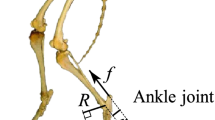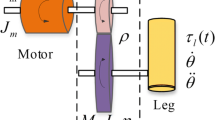Abstract
This paper presents our efforts to explain why mammals have large thigh muscles while insects have small ones. After a discussion of this observation a definition of body foot ratio is defined which describes how animals stand and how their legs are arranged. To investigate the mechanics, we present a closed optimum solution of the body foot ratio for a 2D two-leg walking machine. A multi-walker is used as a case for 3D general analysis, and the numerical simulation is presented. Both 2D and 3D case studies can explain the above observations of mammals and insects. These findings can also be used as a guide for the design of man-made limbed machines.
Similar content being viewed by others
References
Alexander R McN (ed). Advances in Comparative and Environmental Physiology 11: Mechanics of Animal Locomotion, Springer Verlag, Berlin, 1992.
Alexander R McN. Animal Mechanics, Blackwell, Oxford, 1983.
Song S M, Waldron K J. Machines that Walk: The Adaptive Suspension Vehicle, MIT Press, Cambridge, Massachusetts, 1989.
Todd D J. Walking Machine, an Introduction to Legged Robots, Kogan Page Limited, London, 1985.
Raibert M N. Legged Robots that Balance, MIT Press, Cambridge, Massachusetts, 1986.
Fichter E F, Kerr D R. Walking machine design based on certain aspects of arthropod leg design. Proceedings of 22rd ASME Conference, Scotts-dale, Arizona, 1992, 45, 561–572.
Fichter E F, Fichter B. Walking machine based on the beetle leg mechanics. Proceedings of 9th World Congress of IFToMM, Milan, Italy, 1995, 3, 2292–2296.
Zhang S J, Howard D, Sanger D J, Miao S. Walking machine design based on the mechanics of the stewart-platform. Proceedings of 2rd ASME ESDA Conference, London, UK, 1994, 64–8.3, 849–853.
Zhang S J. Multi-Legged Walking Machines: Mechanics, Design and Gait. PhD thesis, University of Salford, 1995.
Chen D H, Tong J, Li C H, Zhang S J, Chen B C. A review of man and animal gait and walking robot. Journal of Jilin University (Engineering and Technology Edition), 2003, 33, 121–125, in Chinese.
Zhang S J, Sanger D J, Howard D. Work-spaces of a walking machine and their graphical representation. Part I: Kinematics workspaces. Robotica, 1996, 14, 71–79.
Zhang S J, Howard D, Sanger D J. Work-spaces of a walking machine and their graphical representation. Part II: Static workspaces. Robotica, 1996, 14, 219–226.
Zhang S J, Howard D, Sanger D J, Miao S. Multi-legged walking machine body designs. Robotica, 1998, 16, 593–598.
Howard D, Zhang S J, Sanger D J. Multi-legged walker design—The joint torque versus workspace compromise. Journal of Mechanical Engineering Science, 1997, 211, 477–488.
Author information
Authors and Affiliations
Corresponding author
Rights and permissions
About this article
Cite this article
Zhang, Sj., Tong, J., Hapeshi, K. et al. Optimising body layout design of limbed machines. J Bionic Eng 4, 117–122 (2007). https://doi.org/10.1016/S1672-6529(07)60023-7
Published:
Issue Date:
DOI: https://doi.org/10.1016/S1672-6529(07)60023-7




